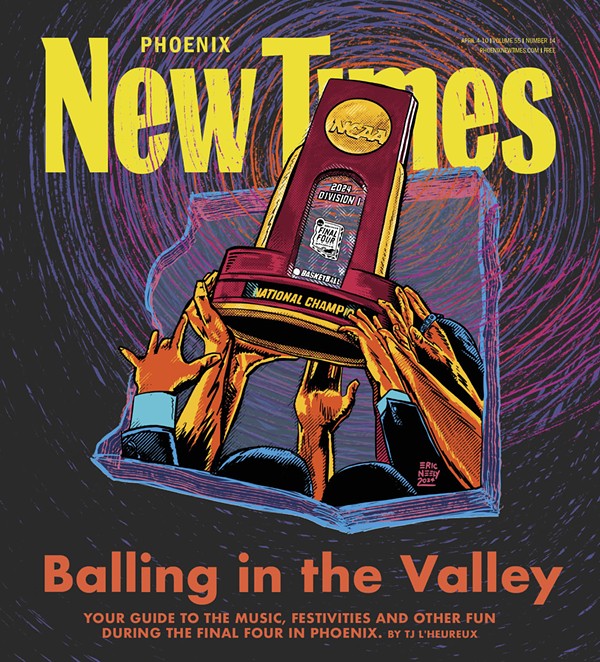So begins a 1992 segment of "The Rest of the Story," a syndicated program in which radio commentator Paul Harvey "completes" a tale by revealing behind-the-scenes information in that halting, highly inflected, unmistakable Paul Harvey style.
In this segment, Harvey breathily tells his listeners that Johnson was once well-off. He had developed a prosperous company that provided satellite communications systems for merchant ships.
But then Johnson's partner was accused of committing a securities fraud. Johnson himself was charged with aiding and abetting.
Having lost his business in the wake of the scandal, Johnson was looking for a way to make money. He discovered a talent by accident.
. . . He got this idea for selling small bronze statues of football players through NFL franchises. He was certain of his market, but he couldn't find a sculptor whose work pleased him. So one night he took home some clay and decided to sculpt a football player himself. And whaddaya know! It looked pretty good.
In 1982, Harvey continues, Johnson was convicted in regard to the fraud--despite his insistence of innocence--and sentenced to 25 years in prison.
There were times Snell thought that he wouldn't make it through, even times he considered tying his bedsheets together and hanging himself.
Five years later, Johnson was paroled, Harvey intones.
It was time to start over. But how? Doing what? And then Snell remembered the little bronze football players. It would never make him rich, he reasoned, but he needed to find some kind of work, something an ex-con could do without being asked a lot of questions.
So, Harvey relates, Johnson moved to Mesa and began to sculpt.
. . . Now let's flash forward to 1992, this year. This year, you visit the Scottsdale Galleria in Scottsdale, Arizona. You will be drawn to an establishment called the Artex Galleries. . . . And the solitary artist whose work is represented here last year sold three and a half million dollars' worth of monument-size statues.
His name--quickly becoming legendary in the American artistic community--is Snell Johnson. That's right, the same Snell Johnson. But some of us still remember those first little bronze football players, and the very heavy price that one artist paid to be vindicated--and now to be celebrated . . .
And now you know The Rest of the Story.
Not quite.
It is certainly true that Snell Johnson has become well-known for his sculpture.
His larger-than-life bronze horses, deer and people are mounted at the entrances of Indian casinos, residential subdivisions and tourist attractions all over the West.
A pair of Johnson's eagles grace the lawn of Paul Harvey's home in the Arizona Biltmore Estates.
Boxer Mike Tyson recently commissioned Johnson to create life-size statues of Alexander the Great, Hannibal and Genghis Khan, along with a gargantuan Islamic priest, kneeling in prayer, that will be placed in the middle of Tyson's swimming pool at his Las Vegas home.
By employing shortcuts--he creates some of the forms he will bronze with foam, rather than the traditional method of crafting wire skeletons--and working long hours, Johnson has become to bronze sculpture what Judith Krantz is to literature: prolific and commercial.
And whether they are masterpieces or Western schlock, Johnson's artworks clearly do have value. At times, however, that value may be related as much to the IRS code as to artistic judgment: Snell Johnson has marketed at least some of his sculptures as sophisticated tax shelters.
In fact, Johnson's financial past and present are far more complicated than Paul Harvey's description would suggest.
(Harvey did not respond to repeated requests for an interview; Johnson says the two met when Harvey visited Johnson's gallery at the Galleria.)
Federal court documents call Johnson a career swindler who has used the names of Mormon Church officials to further his scams. His 1982 conviction--a prosecutor remembers the crime as the most egregious white-collar fraud he's ever seen--was not Johnson's first brush with the law. In 1974, he pleaded guilty to selling unregistered securities. He was convicted of lying to a bank in 1979.
And in the years since his 1987 release from prison, Johnson has drawn the wrath of investors and employees--some of them Mormons--who say he owes them money--sometimes large amounts of money. At least one investor is accusing him in court papers of returning to old ways by committing securities fraud.
The recent complaints about Johnson are spelled out in a series of lawsuits filed in federal and state court in Phoenix:
* Robert Russoli, a Pennsylvania businessman, is suing Johnson and his companies--Artex, The International Fine Art Exchange, Inc., American Heritage Group, American Art and Artex Galleries--claiming he invested almost $200,000 in an online art sales business, but much of that money was diverted to other Johnson enterprises. Russoli also charges that Johnson sold unregistered securities.
* Ron Lee, a former employee who has sued Artex, claims in court papers that the Securities and Exchange Commission began investigating Johnson's companies in 1993. Another former Artex employee also said she has been told of the investigation. (The SEC refused to confirm or deny any such investigation.)
* Edwin MacDonald, a Mesa orthodontist who was a Mormon missionary with Johnson more than 30 years ago, has obtained a $562,000 judgment in civil court against American Heritage Group, a trust controlled by Johnson. The judgment came after MacDonald sued, demanding repayment of a series of loans he had made to Johnson. MacDonald didn't return calls from New Times.
* Rich Rampton, a fellow missionary of Johnson and MacDonald, sold bronzes for Johnson. Fired in late 1995, Rampton is suing Johnson for commissions he says he's owed. (Johnson says he owes Rampton nothing.)
"I'm a bit hesitant to say much," Rampton says, when reached at his Utah home, "because, you know, if it hampers his [Johnson's] ability to make money, then I don't get my money. You understand that?"
But the lawsuits only tell recent portions of the Snell Johnson saga. Here is the rest of the rest of the story.
Snell Johnson chuckles, remembering the time a television reporter asked him, "Isn't it neat to do the thing you enjoy most for a living?"
"I said, 'Yeah, but you don't know what that thing is.'"
"She says, 'Well, it's obviously artwork.'"
"And I said, 'No, selling. Artwork is the thing I like to do second.'"
Dressed casually--a golf shirt, khaki shorts and running shoes--Johnson leans back in the leather chair in the office adjacent to his foundry and toys with a rubber band. His desk is stacked with financial documents; the walls are lined with his oil paintings.
Johnson says he painted in prison, then shipped his work to his sons, who sold the pieces for $400 each.
The deep-hued desert landscapes--usually complete with horse and rider--are reminiscent of the finished product of a paint-by-numbers kit. They might pass as motel-room art. But Johnson says his prison paintings are now worth at least $20,000 each.
"If I had to just do artwork, I would like it," he says. "But I have to be out there, I have to be selling a bigger piece, a more complicated design, a new idea. To me, that's what my high is. It's always been my high."
After returning to Utah from his missionary work for the Mormon Church in Australia in the early '60s, Johnson sold cookware, china and sewing machines door to door. Johnson says he moved on to life insurance sales, then went into business for himself.
Raymond Coughlan, an assistant U.S. attorney in San Diego who prosecuted Johnson in 1982, recapped Johnson's background a bit differently.
"In essence," Coughlan wrote in a 1983 sentencing memorandum filed in federal court, "Snellen M. Johnson has had one career dating back at least until 1968: He is a swindler. He has brought misery to hundreds of people, including investors, employees and vendors."
That misery started when Johnson created Navsat Systems, Inc., a company that marketed a satellite navigation system for merchant ships.
In his sentencing memorandum, Coughlan wrote that "the evidence showed that while that company [Navsat] clearly had promise and the potential to develop a good product, it closed without funds in late 1969 despite having raised over $1 million."
Johnson then created American Ranch and Recreation, a company designed "to provide a recreation facility on a membership basis for people to vacation."
But, Coughlan wrote, "[w]hile hundreds of thousands of dollars worth of shares and memberships were sold in American Ranch and Recreation, little in the way of actual development occurred, and the company was eventually put out of business by the Attorney General of Utah."
The failure of American Ranch and Recreation resulted in Johnson's first known run-in with the law.
Johnson and his brother Lyle pleaded guilty in 1974 in state court in Utah to charges they had sold unregistered securities in American Ranch and Recreation.
Except in situations that involve a very limited number of savvy investors, state and federal laws require a company to register its securities--and file a business profile that explains possible gains and risks associated with a stock purchase--at the Securities and Exchange Commission. These filings enable the government to monitor stock sales and--at least in theory--give investors accurate information on companies seeking capital.
The charge that the Johnsons sold unregistered securities was originally filed as a felony; it was reduced to a misdemeanor in a plea bargain. The guilty plea was a mistake, Johnson says now, claiming he was innocent.
"I pled guilty to it because I thought that was the easiest way to get it over with and get on," he says.
As part of the plea bargain, Snell and Lyle Johnson were ordered to repay approximately $700,000 to investors.
But court records say the Johnsons used illicit means to repay the money. Those records state that Snell Johnson sold stock in Navsat and diverted that money to repay American Ranch and Recreation investors.
Coughlan wrote that he spoke with the assistant attorney general of Utah, who was supposed to collect the $700,000 fine, but didn't.
"[O]ne of the reasons he stopped pursuing such repayments was because he thought it was absurd that Johnson continued to rob Peter to pay Paul," Coughlan wrote.
In the sentencing memorandum, Coughlan noted that Johnson continued to solicit investments in Navsat, bringing in more than $2 million during 1975 and 1976. And, the prosecutor said, evidence "clearly showed" that Johnson had lied to get the investments.
"For example," Coughlan wrote, "investors believed that special arrangements existed with Comsat, IBM, RCA, Union Oil, Exxon, McMullen and Co., MBB, Sperry Univac and prominent German financiers. None of these claims was true. Navsat had done no work to perfect the system which had been begun in 1968 and 1969 in the five intervening years."
And finally, Coughlan said Johnson had used the names of leaders of the Mormon Church in his illegitimate investment solicitations. "Mormon Church members comprised the majority of victims in Johnson swindles. The use of religion to sucker investors is, of course, singularly sickening," the prosecutor wrote.
One Mormon investor was Sterling Sill, one of the church's highest authorities and the father of one of Johnson's fellow missionaries in Australia.
Five years after pleading guilty to selling unregistered securities in American Ranch and Recreation, Johnson was back in criminal court.
Court records show that in 1979, Johnson was convicted in the United States District Court of Utah for making false statements in loan applications to a federally insured bank.
In 1975, Johnson and/or his representatives at International Resources, a holding company for Navsat and American Ranch and Recreation, received $100,000 in loans from the Commercial Security Bank in Murray, Utah.
Equipment supposedly belonging to American Ranch and Recreation had been offered as collateral to back the loan; however, the trial revealed that neither Johnson nor International Resources owned the equipment, and the real owners had never agreed to its use as collateral.
Johnson was convicted on six counts of a ten-count indictment.
His sentence for that crime included time in a halfway house; there, Johnson began his sculpting career.
And not long afterward, he was the target of new fraud charges, these filed in the U.S. District Court for Southern California.
During a three-month trial in 1982, Johnson and a business associate, Spencer Hooper, were found guilty on a variety of fraud-related charges surrounding their misrepresentation of the financial state of Navsat. Johnson was sentenced to five consecutive five-year sentences. Hooper received two five-year sentences.
Johnson insists that Hooper was the ringleader, and that he, Johnson, was found guilty only of aiding and abetting Hooper.
"They convicted me of aiding and abetting fraud," Johnson claims. "Another guy [Spencer Hooper] had not registered his shares and was selling them on the market. I had nothing to do with it, but they didn't want him, they wanted me, because I . . . had told them they could go to hell, and they couldn't push me around, and it was just a personal vendetta."
Johnson, however, can't explain why the verdict in the case found him guilty of 30 counts, including six counts of "mail fraud and aiding and abetting mail fraud," six counts of "securities fraud and aiding and abetting securities fraud" and 18 counts of "wire fraud and aiding and abetting wire fraud."
Spencer Hooper was found guilty of 25 counts of fraud.
Johnson hems and haws when he hears the language of the verdict.
"I don't know if technically I was guilty of both," he says. "But I ended up in a position of aiding and abetting Spencer Hooper and so, I don't know, I mean, maybe, it could be. It's been a long time since I've read it."
In recommending a much harsher sentence for Johnson than for Hooper, Coughlan wrote: "By contrast to Snellen Johnson, Spencer Hooper's criminality is almost unremarkable."
Today, former assistant U.S. attorney Raymond Coughlan is a defense attorney specializing in criminal and civil fraud cases. Reached at his San Diego office, he recalls the Johnson case instantly, although it's been more than a dozen years since Snell Johnson was sent to prison.
"The case had the most overwhelming proof of fraud that I've ever been associated with to this day," Coughlan says.
Bob Russoli and Snell Johnson met in late 1990, during a rodeo at Rawhide, a steak house and Western mini-theme park in Scottsdale. Russoli, a Pennsylvania businessman, was taken with Johnson's bronzes, which were on display in a booth. A few days later, Russoli visited Johnson's gallery at the Galleria and purchased some art.
Several months later, Russoli decided to invest in Johnson's newest business, an online art gallery that was promoted as a way of offering buyers the chance to view art on their computers and place orders from home. Johnson says he had been working on the concept for more than a decade; advancing computer technology was finally going to make it a reality.
In a 1993 lawsuit filed in Maricopa County Superior Court, Russoli claims he invested $175,000 in Artex stock--but Johnson or others at Artex actually diverted the funds to other purposes.
"For example, the $75,000 Russoli wired to American Heritage Group on December 13, 1991, was never deposited into Artex's account," the suit claims. "Similarly, of the $100,000 Russoli wired to Artex on January 15, 1992, $30,000 was diverted into American Heritage Group, $10,000 was diverted to Artex Galleries, $20,171.01 was diverted to American Art." All three firms are controlled by Johnson.
In a court filing, Johnson denies that he diverted the money.
Johnson has, however, admitted at least some of the irregularities alleged in the suit. In a deposition, Johnson acknowledged inaccuracies in a management statement made in Artex's business plan, which was provided to potential investors. The statement listed the Royal Bank of Scotland, London, U.K. as one of Artex's bankers, Deloitte & Touche of Phoenix as its accounting firm and the New York law firm of Snow, Becker and Kraus as its legal representative.
None of that was true, Johnson admitted.
Russoli's attorneys also allege that Johnson is guilty, once again, of selling unregistered securities. In a sworn affidavit dated December 1994, I. Douglas Dunipace--an attorney with the Phoenix law firm of Jennings, Strouss & Salmon and an expert witness for Russoli--wrote that he believes Artex stock was sold illegally in 1991 and 1992, because it was not registered with state or federal securities regulators.
Dunipace claims Artex did not prove that potential investors had the wherewithal to determine if the business was healthy; in addition, he notes, potential buyers were not provided with an audited balance sheet for Artex. And, the attorney contends, Artex's marketing plan contained incomplete and misleading information.
Johnson's attorneys, however, claim the offering of stock was sold to just seven individuals and three businesses, all knowledgeable in financial matters.
Via his attorney, Russoli refused an interview with New Times.
Johnson says, "It was a very complicated thing because he and three other guys tried to steal a company from me and the other stockholders, and I kicked him out, and so now he wants his money back that he had invested after he got kicked out."
He refuses to elaborate.
Russoli v. Artex is expected to go to trial sometime in the next several months. But the Securities and Exchange Commission may have a jump on Russoli. Although SEC officials refuse to comment, former Artex employees claim the SEC began investigating Johnson's business holdings in 1993.
The Artex International Fine Art Exchange finally went online earlier this year. But in 1993, all of Artex's employees were dismissed and told the company was out of money. In a claim for back pay filed in Maricopa County Superior Court, former Artex advertising/marketing manager Ron Lee described a meeting in June 1993, in which Artex president Tom Larkin announced his resignation.
Lee wrote, "[H]e [Larkin] notified us that he could not receive, or take, or even try to persuade an investor to provide any more funding because of an SEC investigation (then in a 'start-up' mode) and targeting its focus on Artex Int'l and Mr. Snell M. Johnson. After this information he then said we should seek employment elsewhere."
Lani Gore, who at the time was Artex's accountant, confirms the events as recollected by Lee.
"There was definitely an SEC investigation," she says, recalling that other Johnson employees were called upon to pull documents requested by the SEC.
Snell Johnson has been convicted three times for misleading people about investments and is the target of several lawsuits alleging recent fiscal legerdemain. But is finance connected in any way to Johnson's art? Why is the western United States being littered with enormous bronze horses, buffalo and Native Americans, all of whom have faces resembling Yoda from The Empire Strikes Back? Why are people paying large sums of money for sculptures that will never be mistaken for the work of Rodin?
Of course, customers may buy Johnson's work simply because they like it. In at least some cases, however, the decision to purchase may focus on financial as well as artistic considerations.
Last year, a potential Johnson customer received a form titled "Financial Benefit Profile Created by Donating Art Monument."
The form provides an example of how a purchase of Snell Johnson sculpture might shelter significant amounts of income from federal tax liability. In the example, a sculpture purchased from Johnson for $100,000 is projected to double in value a year after the sale. If the sculpture were then donated to a nonprofit entity, the form says, that charitable donation could reduce the original purchaser's taxable income by $80,000, if he or she were in a 40 percent tax bracket. (That is, 40 percent of the $200,000 value of the art is $80,000.)
Johnson's form, of course, offers the caveat that each client's tax situation is different. The form does not suggest that clients take any actions that are, per se, illegal.
But the sales pitch does not dwell much on evaluating fine art, either.
During preparation of this story, more than a dozen gallery owners, artists, public-art experts and curators were asked to assess the artistic aspects of Johnson's sculpture. All refused, either claiming they didn't know the work well enough or saying they simply didn't want to comment publicly on his work.
But Robert Schultz, a former registrar at the Phoenix Arts Commission, was willing to recount one anecdote about a Snell Johnson art proposal. In the early 1990s, Schultz recalls, Johnson offered the city a free bronze to be placed near America West Arena in exchange for the right to sell smaller versions of the sculpture. The city refused the "donation."
"Snell basically had offered Jerry Colangelo and the Suns a huge, double life-size sculpture of a basketball player going up to slam a ball into a basket, and at that time, the arts commission had a gifts and loans policy where any artwork that was to be placed on city property had to go through a review process through the arts commission," Schultz recalls.
"It wasn't accepted," he says.
"As I recall, they felt that just simply the quality of the maquette--the model that was submitted--was just not up to standard of what they would have liked to see in a major artwork outside of a major venue."
Even for the low, low cost of--nothing?
"The artistic quality was the first criteria," Schultz says, "and in their opinion, it didn't pass muster.











